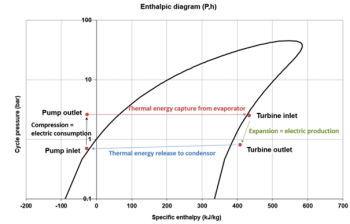The FPT/IVECO base engine was installed and measured to determine the baseline. Following that, it was upgraded with eTurbo, WHR and a specific cranktrain, all aimed at reducing fuel consumption. After each step, measurements were carried out to accurately determine the benefits on fuel consumption.

The e-WHR used in the LONGRUN project is a system able to recover thermal energy available in the coolant fluid and is devised and supplied by IFPEN, with the cooperation of Enogia.
The energy harvested from the coolant, which usually operates around 90 degC, is used to evaporate and overheat another fluid (cyclopentane), while raising its pressure: the overheated cyclopentane is then used to move an e-turbine (i.e., a turbine with an electric generator installed on its shaft), which produces electrical energy.
At the turbine outlet, the cyclopentane is condensed, so that it is ready for a new cycle. The process described above is called Organic Rankine Cycle (ORC), because the cyclopentane is an organic working fluid. The thermodynamic process is shown in the figure below.

The e-WHR is not mechanically connected to the engine, and it is located on a skid, where all the ORC system components are installed.

The e-WHR is connected only to the engine cooling circuit and to the test bench cooling circuit, and these connections do not require any particular study. The working fluid inside the e-WHR is, as mentioned, cyclopentane, i.e., a hydrocarbon: the possible leakages from the circuit could lead to explosive mixtures inside the test cell, where very hot surfaces (e.g., the exhaust manifold) are present, as well as electrical components: this results in an explosion risk, which must be avoided.
This topic is addressed in the ATEX regulation, which describes the minimum safety requirements for workplaces and equipment used in explosive atmospheres. In the legislation, the following zones are defined, as a place in which an explosive atmosphere consisting of a mixture of air or dangerous substances in the form of gas, vapor, or mist…
- zone 0 – …is present continuously or for long periods or frequently
- zone 1 – …is likely to occur in normal operation occasionally
- zone 2 – …is not likely to occur in normal operation, and if it does occur, will persist for a short period only.
According to the zone characterization different safety measures must be put in place.
A thorough analysis was performed by Enogia in order to verify whether the test cell would fall in one of the zones described above: the conclusions is that the test cell, even in the presence of the e-WHR system and cyclopentane, is not subject to any constraints due to ATEX regulation thanks to of the very effective ventilation system, which prevents the formation of explosive mixtures even in case of a cyclopentane leakage.
The test cell is by default equipped with sensors to detect the leakage of natural gas. Dedicated cyclopentane sensors were ordered and will be replace the gasoline sensors (which are not required as no gasoline is used) so as to detect cyclopentane leakages, and thus are able to activate the emergency procedures if required.